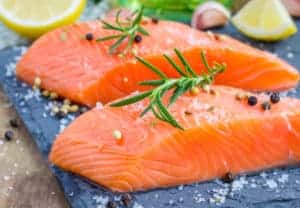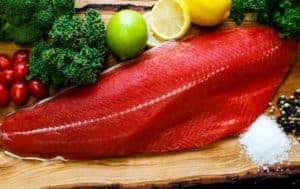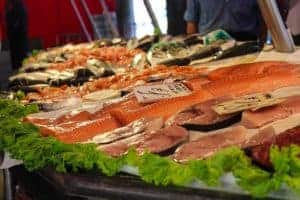
Farmed vs. Wild Salmon
The Great Debate
Do you have confusion in the salmon aisle? Have you ever wondered, what’s the difference between farmed salmon versus wild salmon? Is one better nutritionally? And what’s the deal with some salmon saying “Pacific” and other salmon saying “Atlantic”? Today, we will be breaking down the science so you know what to buy when fishing for your salmon.
Before we dive in, let’s first talk omega 3’s. Omega 3’s are our heart-healthy fats that have anti-inflammatory properties. Omega 3’s lower risk of heart disease and risk of certain cancers. They are also important in brain, nerve and eye development for infants. They may improve our immune system and may play a role in the prevention of dementia, Alzheimer’s disease and rheumatoid arthritis.
Wondering the difference between #wild vs. #farmed #salmon? Find out here: Click To TweetHealth Canada recommends adults consume at least two servings of fish per week. One serving is equal to 75 grams or 2 ½ ounces or half a cup of cooked fish. It is recommended to emphasize consumption of fatty fish, like salmon, herring, mackerel, sardines as these types are higher in omega 3’s.
Farmed vs. Wild Salmon

Farmed Salmon
Atlantic Salmon
155 calories / 2.5 oz
Higher
Same
Higher, but still below Health Canada cutoffs considered safe
Cheaper
Artificial feed like grains
Pigment added
Less environmentally sustainable
Not often canned, unless it says Atlantic
Higher in folate and vitamin A

Vs.
Also Known As
Calories
Omega 3 fats
Protein
PCB's (chemicals stored in fat of fish)
Cost
Fish Feed
Colour of fish
Environmental
Canned salmon?
Nutrients

Wild Salmon
Pacific Salmon
115 calories / 2.5 oz
Lower
Same
Lower, but still contain PCB's
More Expensive
Natural ocean sources of food
Natural colour
More eco-friendly fish
Yes
Higher in potassium and selenium
Bottom Line:
Next time you are perusing the fish aisle, keep in mind that “Atlantic” salmon is farmed and “Pacific” salmon is wild. These different types of salmon vary in size, calorie content as well as omega 3 content among other attributes. However, both options are healthy and good ways to get more omega 3’s in your diet (which most of us are not getting enough of). If you eat salmon more than twice a week, you can find it worth buying some wild salmon to decrease total intake of PCB’s. When it comes to the salmon debate, it still looks like the benefits of eating more salmon, either wild or salmon, outweigh the risks.
Looking for delicious #salmon recipes? We've got you covered: Click To TweetPs. If you are looking some delicious salmon recipes, here are some of my favourites:
If you are not a fan of fish and wanting to ensure adequate omega 3 consumption, check in with your registered dietitian.


